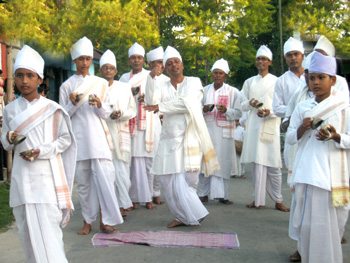Xorai, a cherished symbol of Assam’s rich cultural heritage, embodies tradition, craftsmanship, and profound symbolism. From adorning sacred rituals to gracing social ceremonies, Xorai holds a special place in the hearts of Assamese people. Let’s delve into the intricate world of Xorai and uncover its significance within Assamese traditions and culture.
Origins and Historical Significance
Xorai, with its roots deeply embedded in Assam’s history, traces back to ancient times. Crafted from bell metal, these intricately designed vessels serve as offerings in religious ceremonies and symbolize prosperity and hospitality. Legend has it that Xorai originated during the reign of the Ahom dynasty, where it was used to offer betel nuts and leaves to guests as a gesture of respect and honor.
The Artistry of Xorai Making
Crafting a Xorai requires meticulous skill and precision passed down through generations. Artisans meticulously shape molten bell metal into exquisite designs, often featuring motifs inspired by Assamese flora and fauna. Each Xorai is a testament to the craftsmanship and dedication of Assamese artisans, reflecting the region’s rich artistic heritage.
Symbolism and Cultural Significance
Xorai transcends its utilitarian purpose and embodies deep cultural symbolism. As a symbol of prosperity and abundance, it is often used in auspicious ceremonies such as weddings and religious rituals. Additionally, Xorai serves as a mark of respect and hospitality, adorning the homes of Assamese families and welcoming guests with warmth and generosity.
Variations and Regional Influences
Throughout Assam, variations of Xorai can be found, each bearing distinct regional influences. From the intricately crafted designs of Upper Assam to the simpler yet elegant styles of Lower Assam, Xorai reflects the diverse cultural tapestry of the region. Each variation tells a unique story, preserving the rich heritage and traditions of Assamese culture.
Preserving Assamese Heritage
In recent years, efforts have been made to preserve and promote the tradition of Xorai making. Artisan communities and cultural organizations are working tirelessly to ensure that this cherished art form continues to thrive for future generations. By supporting local artisans and celebrating Assamese craftsmanship, we contribute to the preservation of our cultural identity.
FAQs:
What materials are used to make Xorai?
Xorai is traditionally crafted from bell metal, a combination of copper and tin, renowned for its durability and lustrous finish.
Common motifs include the one-horned rhinoceros, lotus flowers, elephants, and other elements inspired by Assamese folklore and nature.
What are some common motifs found in Xorai designs?
How is Xorai used in Assamese rituals?
Xorai is often used to hold offerings during religious ceremonies, weddings, and festivals. It is also used to serve traditional Assamese delicacies.
Conclusion
Xorai stands as a timeless emblem of Assam’s cultural heritage, embodying tradition, craftsmanship, and profound symbolism. As we continue to celebrate and preserve this cherished art form, we honor the legacy of our ancestors and keep alive the spirit of Assamese traditions for generations to come.












